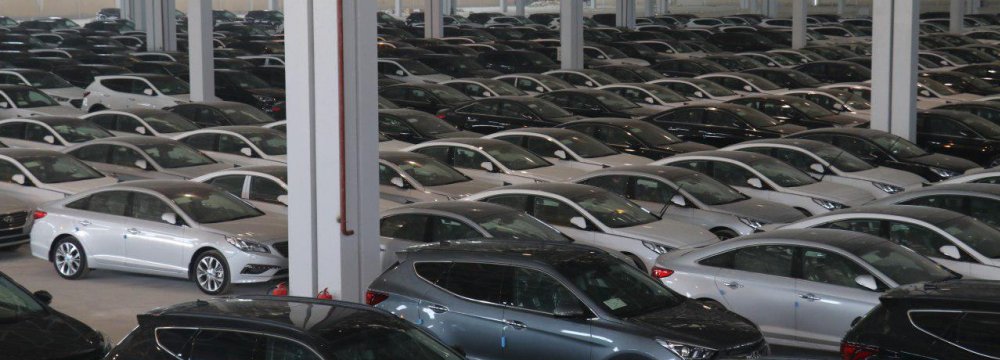
Car Importers in Iran Have a Field Day

The rumor mill has it that the erratic situation is because of unconfirmed reports suggesting that the Ministry of Industries is planning to increase auto import tariffs by up to 100%, local automotive website Asbe Bokhar reported.
The minister, Mohammad Shariatmadari, has often been quoted by local media as saying that “auto import rules will change soon.”
Earlier in November, he said, “The ministry has proposed to the government new guidelines for importing cars.”
However, since his appointment three months ago he has not shared anything with the public nor has said what actually his ministry’s action plan is about returning stability to the imported car market.
Over the weeks, mass media and automotive websites have published several supposedly ‘leaked’ proposals, none of which can be confirmed by Financial Tribune. Almost all of the reports suggest that the import tariffs are to observe whooping increases.
As things stand now, importers pay over 100% of the value of the vehicles to the government and affiliated bodies. Import costs are not limited to tariffs because several government bodies have a share of the lucrative business, in that the importing company or car buyer must pay a variety of extra charges, taxes and other overheads before the vehicle is ready for the road!
For instance, the local Traffic Police department charges importers 10% of the car value when issuing number plates. Furthermore, dealers are required to pay 1% tax to the local Red Crescent -- the money reportedly is used for buying ambulances.
Raw Deal
Avaricious dealers have fleeced Iranian car buyers forever. Imported cars almost always cost twice over and above the prices in international markets. Why? The interpretation is wide open from protecting the dysfunctional local auto industry to running the country on tax revenues instead of oil.
With officialdom keeping the public in the dark, middlemen and greedy brokers have a field day and the people get a raw deal.
The price of the hybrid Hyundai Sonata has risen 210 million rials ($5,250) since August, 10% just in the last week. The car is sold for 1.86 billion rials ($46,500) in Iran. The same South Korean vehicle is offered at less than half this price in the international market, but has few buyers.
Hyundai Tucson has also had a huge jump from 1.86 to 2.1 billion rials ($46,500 to $52,500) in the past three months. Elantra’s price also rose from 1.6 to 1.63 billion rials ($40,000 to $40,750) last week. The model is available in foreign markets for anything between $26,500 to $28,500.
KIA is another popular brand. The Cerato sold for 1.43 billion rials ($35,750) back in August but is now priced at 1.6 billion rials ($40,000).
The price of this car shot up 30 million rials ($750) in less than a week.
The KIA Optima, one of the beautiful luxury sedans, is dearer by 70 million rials ($1,750) and is offered at 2.1 billion rials ($52,500). The same company’s Sportage SUV has also had a huge jump rising from 1.75 to 2 billion rials ($43,750 to $50,000). Both models start at $25,000 in the international market.
Hyundai’s Santa Fe, which is popular with people who can afford expensive cars, has registered the biggest increase in price. It is currently sold for 2.7 billion rials ($67,500) -- up 280 million rials ($7,000) over the past 90 days.


Gold price eases after Trump downplays clash with Fed chair Powell

Copper price hits new record as tariff deadline looms

Brazil producers look to halt pig iron output as US tariff threat crimps demand

Chile’s 2025 vote puts mining sector’s future on the line

Gold price could hit $4,000 by year-end, says Fidelity

Three workers rescued after 60 hours trapped in Canada mine

US targets mine waste to boost local critical minerals supply

Glencore workers brace for layoffs on looming Mount Isa shutdown

Energy Fuels surges to 3-year high as it begins heavy rare earth production

Trump tariff surprise triggers implosion of massive copper trade

Maxus expands land holdings at Quarry antimony project in British Columbia

BHP, Vale accused of ‘cheating’ UK law firm out of $1.7 billion in fees

Southern Copper eyes $10.2B Mexico investment pending talks

American Tungsten gets site remediation plan approved for Ima mine in Idaho

Kinross divests entire 12% stake in Yukon-focused White Gold

Gold price could hit $4,000 by year-end, says Fidelity

Southern Copper expects turmoil from US-China trade war to hit copper

Ramaco Resources secures five year permit for Brook rare earth mine in Wyoming

Column: EU’s pledge for $250 billion of US energy imports is delusional

Trump tariff surprise triggers implosion of massive copper trade

Maxus expands land holdings at Quarry antimony project in British Columbia

BHP, Vale accused of ‘cheating’ UK law firm out of $1.7 billion in fees

Southern Copper eyes $10.2B Mexico investment pending talks

American Tungsten gets site remediation plan approved for Ima mine in Idaho

Kinross divests entire 12% stake in Yukon-focused White Gold

Gold price could hit $4,000 by year-end, says Fidelity

Southern Copper expects turmoil from US-China trade war to hit copper

Ramaco Resources secures five year permit for Brook rare earth mine in Wyoming














